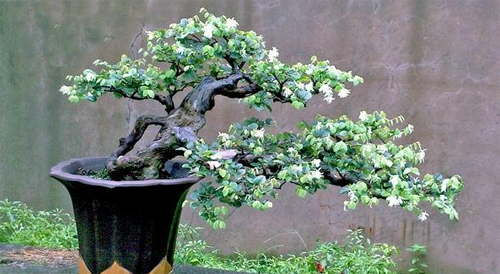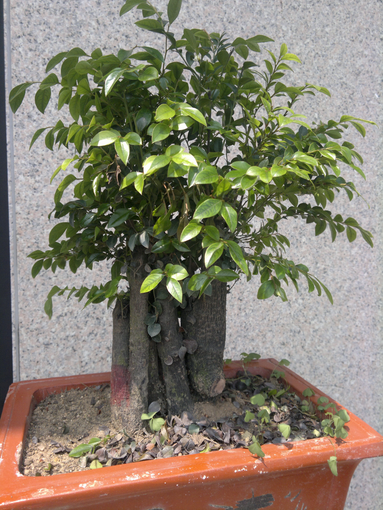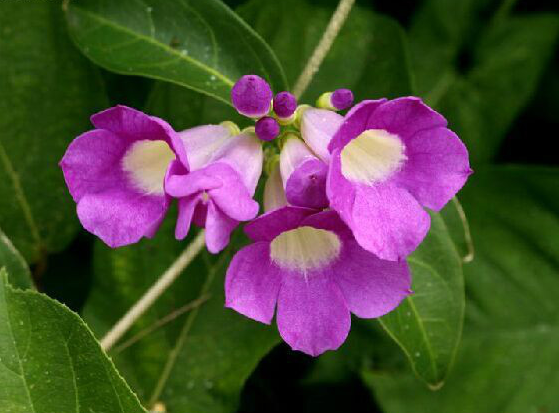What is the price of the culture method of bonsai with white flowers?
White flowers are often seen by the roadside before. It is very good-looking and attractive. The flowers are like tassels or red. White flowers can also be made into bonsai. Let's take a look at the cultivation method of bonsai. How much is the price?

The culture method of bonsai of Euphorbia crassipes:
Carthamus tinctorius likes light and is slightly shady (it is OK to grow in the shade in pots), but the leaf color is easy to turn green in shade.
It is very adaptable and resistant to drought. It likes to be warm, cold-resistant, sprouting and branching, and resistant to pruning. It is resistant to barren, but it is suitable to grow in fertile, moist slightly acidic soil.
1. Fertilization
Carthamus tinctorius is used for foliar topdressing with neutral foliar fertilizer diluent during the growing season and sprayed 2-3 times a month to promote shoot growth, of course, if the soil is fat enough, you don't need to care at all!
Warm Tips for Summer:
In the southern plum rain season, attention should be paid to keeping good drainage, and in the hot and dry season, watering should be ensured once in the morning and evening, combined with spraying water at noon to cool down.
If the soil and air in the north are dry, we must water the soil in time, keep the soil moist, spray water in autumn, winter and early spring, and keep the leaves clean and moist.
2. Pruning
Due to the characteristics of strong sprouting and resistance to pruning, light to moderate pruning is carried out in early spring and early autumn, combined with normal water and fertilizer management, it can blossom after about 1 month and let the flowering period be concentrated.
This method can promote the development of new branches and leaves, make the tree more beautiful, prolong the red period of leaves, and promote and control the florescence, especially suitable for red oak bonsai to participate in flower exhibitions and trade fairs, which can enhance the exhibition effect and promote product sales.
3. Picking leaves and wiping tips
In the growing season, the mature leaves and shoots of Castanopsis carlesii are removed and the tender shoots can be extracted again after normal management for about 10 days, and bright red new leaves can grow.
4. Sunshine
Choose sunny environment for cultivation, or prune the plants arranged in the southeast and above of the tree, so that the tree can grow healthily in sufficient sunlight and make the flowers and leaves more beautiful, so as to enhance the ornamental.
Common diseases of Artemisia mandshurica
The most common diseases are anthrax and mosaic.
1. Anthrax:
It can be seen that the disease spot of the leaf shows black round spot, and the harm is serious in the rainy season from July to August. After getting sick, the diseased leaf should be cleared in time, burned centrally, and the source of the disease should be reduced. It is necessary to prune properly and improve lighting and ventilation conditions.
In severe cases, methyl topiramate and chlorothalonil should be sprayed several times to prevent resistance.
2. Mosaic disease
Old leaves and new leaves are white and white, caused by mosaic virus, virus An or other antiviral agents can be used.
How much is the price of bonsai with white flowers?
If it's just a sapling, the price is about 0.8 yuan per plant. This depends on whether you need a basin and whether you need others to be plastic.
The culture methods and matters needing attention of Euphorbia angustifolia
Latin name Loropetalum chinensis (R. Br.) Oliv.
It is also called the white flower tree.
The plant kingdom.
Hamamelidaceae
Belonging to the genus Euphorbia
Plant alpinia chinensis
The distribution area is distributed in the provinces of East China, South China and Southwest China.
Shrubs are usually shrubs, sparsely small trees, up to 12 m tall and 30 cm in diameter; branchlets with rust-colored stellate hairs. It produces the middle and lower reaches of the Yangtze River and its south and north of the Tropic of Cancer. It is also distributed in northern India. Most of them are born in mountains and hilly thickets. Roots, leaves, flowers and fruits can be used in medicine, can antipyretic and hemostatic, channel activating collaterals, convergence hemostasis, heat-clearing and detoxification, antidiarrhoea. Wood characteristics: fine wood, hard, good toughness, suitable for woodworking tools: hammer handle, axe rod, saw nose, planing shell, etc., but the wood is divided into dioecious plants, the tools made of female plant materials are generally better.
1. Introduction
The Chinese name of the species: jelly wood, used to writing successor wood, Fructus Aurantii, shackle wood. For evergreen shrubs or small trees. Alias: Xuancheng dialect chicken willow flower (picture test), paper end flower, thorn wood flower, shackle wood, Jianchai wood (Zhejiang, Jiangxi, Hunan), Jijiagu (Fujian), Jieman (Anhui), Jiwei (Jiangxi, Hunan), cocoon lacquer (Guang Qun fragrance spectrum), hard lacquer, thorn lacquer (Zhejiang), Zhi micro wood (Guangdong), saw strip (Sichuan), with wood (east Sichuan), fishbone wood (Jiangxi), fishbone firewood (Liangguang), Qingming flower (Fujian), Qingming flower (Fujian), Baihuashu (Guangdong), Manshanbai, Jinli paint, Jinqian lacquer (Zhejiang)
2. Morphological characteristics.
Shrubs, sometimes small trees, much branched, branchlets with stellate hairs. Leaves leathery, ovate, 2-5 cm long and 1.5-2.5 cm wide, apex acute, base obtuse, unequal, slightly hirsute or bald above, dark green after drying, dull, stellate hairs below, slightly grayish white, lateral veins ca. 5 pairs, conspicuous above, raised below, entire; petiole 2-5 mm long, with stellate hairs Stipules membranous, triangular-lanceolate, 3-4 mm long, 1.5-2 mm wide, caducous. Flowers 3-8 clustered, short pedicellate, white, opening earlier than new leaves, or at the same time as young leaves, peduncle ca. 1 cm, indumentum; bracts linear, 3 mm long; calyx tube cup-shaped, stellate, calyx teeth ovate, ca. 2 mm, glabrescent after anthesis; petals 4, banded, 1-2 cm long, apex rounded or obtuse; stamens 4, filaments very short, connective prominent angular. Staminodes 4, scalelike, alternate with stamens; ovary completely inferior, stellate hairy; style very short, ca. 1 mm; ovule 1, perpendicular to upper horn of carpels. Capsule ovoid, 7-8 mm long, 6-7 mm wide, apex rounded, brown stellate tomentose, calyx tube long for capsule 2 × 3. Seeds ovoid, 4-5 mm long, black, shiny. The florescence is from March to April.
Evergreen or semideciduous shrubs to small trees, buds without scale bracts. Leaves alternate, leathery, ovate, entire, slightly oblique, shortly stipitate, stipules membranous. Flowers 4-8 arranged in capitate or short spikes, bisexual, 4-numbered; calyx tube obconical, connate with ovary, outer stellate hairs, calyx teeth ovate, protruding; petals banded, white, curled inward at flower bud; stamens perpendicular, filaments very short, anthers with 4 pollen sacs, valvular, connective protruding; staminodes scalelike, alternate with stamens; ovary semi-inferior, 2-loculed, stellate hairs, style 2. Ovules 1 per locule, pendulous. Capsule woody, ovoid, covered with stellate hairs, upper part 2-lobed, each 2-lobed, lower part surrounded by persistent calyx tube and completely connate, fruiting pedicel very short or non-existent. Seed 1, long ovate, black, glossy, navel white; seed coat horny, endosperm fleshy.
3. Species distribution
4 species and 1 variety, distributed in the subtropics of eastern Asia. There are 3 species and 1 variety in China, and the other is in India.
4. Growth habits
Like shade plants, but do not exclude the sun, commonly used as green seedlings, such as fences, green belts.
5. Taxonomy
Carthamus tinctorius can be divided into 3 categories, 15 types and 41 varieties, which are described as follows:
The first kind of tender leaf red
Commonly known as one-sided red, the third generation of Carthamus tinctorius, belongs to the early cultivation type, the main characteristics: leaf medium large, leaf length 1 to 6 cm, width 0.8 to 4.6 cm, petiole length 2 to 5 mm, new leaf purplish red, old leaf perennial green, leaf surface indumentum, poor glossiness. The phloem and xylem of the new shoot are light green. The fibrous root is brownish green. The annual flowering period is 3 times, the spring flowering stage is early, the initial flowering period is early February, the full flowering period is from mid-March to mid-April, and the annual flowering is 75-95 days. According to the different characteristics of leaves, it can be divided into four types: long-leaf green, round-leaf green, sharp-leaf green and fine-leaf green. Among the types, 9 varieties were divided according to the color and petal shape of flowers. Compared with the other two kinds of varieties, this kind of flowers and leaves have poor ornamental ability and have been gradually eliminated in production, but they have strong ecological adaptability, especially strong resistance to high temperature, cold and barren, so they can be used as the original material for variety breeding.
The second kind of bone-penetrating red
Commonly known as the fourth generation of Carthamus tinctorius, it is a variant variety selected by asexual breeding technology on the basis of the first kind of varieties. Main features: the leaf is small, 0.8 to 4.5 cm long, 0.8 to 3 cm wide, petiole 2 to 4 mm long, new leaf purplish red, old leaf adaxially dark green purple, back flour green purple, leaf surface indumentum less than the first type, glossy. The red leaves return to green for a long time in summer. The branches were dense, and the phloem and xylem of the new shoots were purplish red. Fibrous root purplish red. The annual flowering period is 3 to 4 times, in the middle of spring flowering, the beginning of flowering in mid-February, the full flowering period from late March to late April, and 105 to 130 days of flowering throughout the year. According to the characteristics of leaf size, branch density and florescence, it can be divided into seven types: long leaf through bone red, dense branch through bone red, sparse branch through bone red, fine leaf through bone red, spot leaf through bone red, winter Yan through bone red, Fu Di through bone red. In each type, 25 varieties were divided according to the characteristics of flower color, petal shape and so on. This kind of variety has the longest flowering period, rich flower patterns, the most colorful flowers, dense branches, easy to shape, and can be used to create color carvings, small and medium-sized shrub balls. The two varieties of purple red and bright red with fine leaves are especially suitable for cultivating miniature bonsai and grafting to cultivate large stumps. Dongyanhong type is the only variety that blossoms in winter and has high ornamental value.
The third kind of double-sided red
Commonly known as Big Leaf Red, the fifth generation of Carthamus tinctorius is a variant variety type selected by asexual breeding technology on the basis of the second kind of varieties. Main features: the leaf is the largest, 3 to 9 cm long, 1.5 to 5 cm wide, petiole 2.5 to 4 mm long, new leaf purplish red, old leaf adaxially purplish black, abaxially purplish red, leaf surface indumentum less, red bright and moist, summer red leaf turning green period is short. The branches are medium and there are more purplish red fibers in the phloem and xylem of the new shoots. The fibrous root is purplish black. The annual florescence is 3 times, the spring florescence is late, the initial flowering period is late February, the full flowering period is from early April to early May, and the annual flowering is 78 to 95 days. In this class, according to the characteristics of leaf size and shape and branch angle, it can be divided into four types: big leaf red, pointed leaf red, Fu Di red and warped leaf red. In each type, 7 varieties were divided according to flower color, petal shape and other obvious characteristics. The leaves of these varieties are large and ruddy, and the ornamental value is very high. The four varieties with moderate branches and fast growth rate, such as' big leaf red', 'big leaf rose red', 'sharp leaf red' and 'big leaf curly petal red' are suitable to cultivate large color carving and shrub balls.
- Prev

Culture methods and precautions of lobular red sandalwood symptoms of water shortage
Speaking of lobular red sandalwood, the first thing we think of is the handstring. What we are talking about here is the lobular red sandalwood plant. What are the breeding methods of lobular red sandalwood? What do you need to pay attention to? What symptom does lobular red sandalwood appear to be short of water? Lobular red sandalwood culture method: the growth temperature of lobular red sandalwood is 20-30 degrees.
- Next

The cultivation method and reproduction of garlic vine do you want to lose the leaves in winter?
Garlic vine is not generally good-looking, but also can climb the wall, garlic vine flowers are also particularly good-looking, just like a blossom of small trumpet flowers, what are the breeding methods of garlic vine? How do you reproduce? Do you want to lose the leaves in winter? The cultivation method of garlic vine: light and temperature, garlic vine likes light.
Related
- Fuxing push coffee new agricultural production and marketing class: lack of small-scale processing plants
- Jujube rice field leisure farm deep ploughing Yilan for five years to create a space for organic food and play
- Nongyu Farm-A trial of organic papaya for brave women with advanced technology
- Four points for attention in the prevention and control of diseases and insect pests of edible fungi
- How to add nutrient solution to Edible Fungi
- Is there any good way to control edible fungus mites?
- Open Inoculation Technology of Edible Fungi
- Is there any clever way to use fertilizer for edible fungus in winter?
- What agents are used to kill the pathogens of edible fungi in the mushroom shed?
- Rapid drying of Edible Fungi

